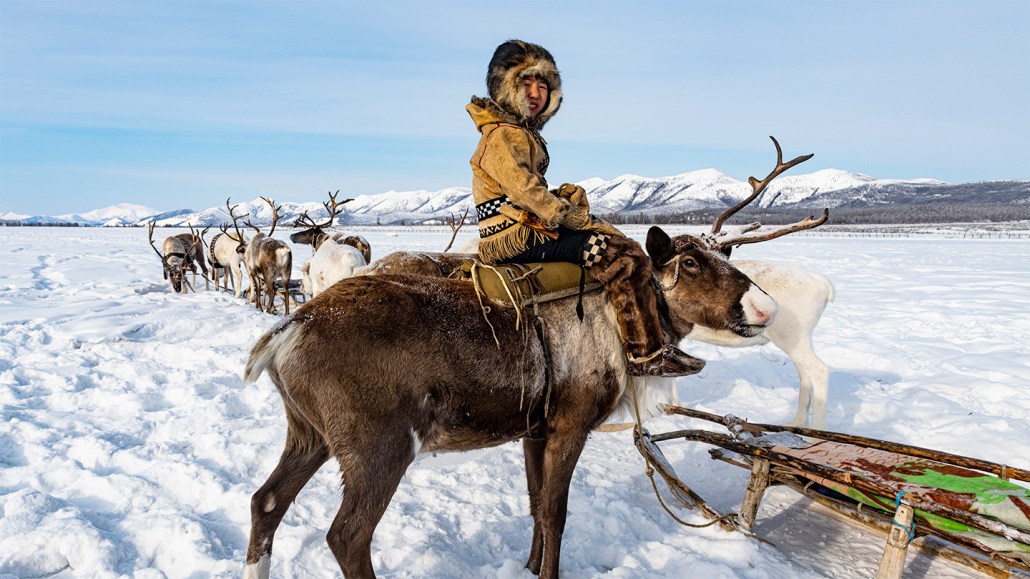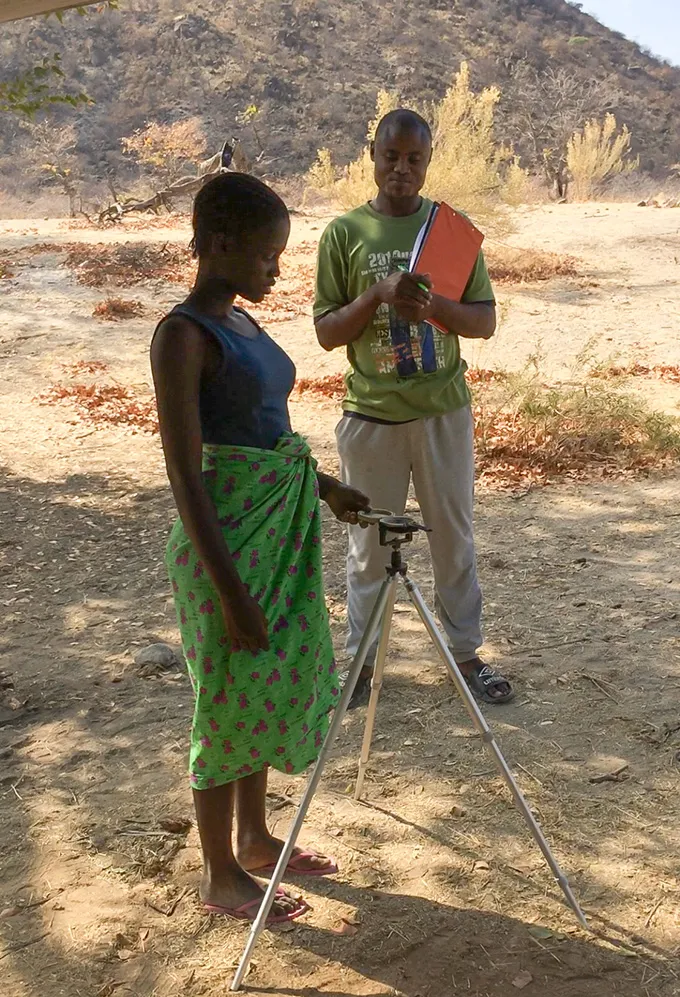Navigation research often excludes the environment. That’s starting to change
Decades of research suggests navigation strategies studied in a lab may not replicate in real life

Evenki reindeer herders in Siberia rely on place names and river flow patterns to navigate.
Michael Runkel/robertharding/Getty Images
On a trip to Siberia in 2019, cognitive scientist Pablo Fernandez Velasco attended a raffle drawing with the region’s Evenki reindeer herders. Prizes included a soccer ball, tea, a portable radio, a GPS unit and other knickknacks. A herder won the GPS. “I thought [that] was one of the fancier prizes,” says Velasco, of the University of York in England. “He was crestfallen.”
The herder, who had been eyeing the radio, had no use for a GPS. He, like other Evenki herders, navigate the vast taiga by heeding their own gait and tracking place names, paths and river flow patterns, a suite of strategies Velasco and geographer Anna Gleizer of the University of Oxford described earlier this year.
But such real-life navigation remains understudied. Instead, researchers have long devoted their time and attention to studying how participants, mostly from the West, “navigate” on a flat computer screen. Such studies scrub out the noisy environment, including tree canopies, wildlife, weather events and other occurrences, to ensure maximum control.
In treating the environment as fixed — as is common across brain and behavior research —scientists operate under the assumption that humans behave the same way regardless of their cultural or environmental milieu, neuroscientist Hugo Spiers of University College London and colleagues write in a forthcoming Royal Society Open Science. Yet, decades of research suggests that findings in a lab may not translate to real life.
“You can do work in a lab in the United States and have everything go flawlessly and then take it out to the field and everything falls apart,” says environmental anthropologist Helen Davis of Arizona State University in Tempe.
Spiers and collaborators argue that researchers should stop using reductionist approaches that eliminate environmental “noise.” Adding the outside world to research is more complex. But newer tools mean researchers can bring that wider world to the lab, or vice versa, while still ensuring a high level of control.
Navigation research is moving from the two-dimensional world on a computer screen to a more realistic three-dimensional world, says Gabriella Vigliocco, a cognitive scientist also at UCL and coauthor of the Royal Society paper. The work isn’t just helping researchers better understand how people navigate their environment. The findings have implications for what we know about human development, public health and the human psyche.
Wilding the lab
Concerns about studying human behavior in unlifelike lab settings date back decades.
“In order to behave like scientists, [experimental psychologists] must construct situations in which our subjects are totally controlled, manipulated and measured,” wrote British psychologist Don Bannister in 1966 in the Bulletin of the British Psychological Society. “We construct situations in which they can behave as little like human beings as possible and we do this in order to allow ourselves to make statements about the nature of their humanity.”
But setting up rigorous, reproducible experiments with the messy, unpredictable environment was simply too hard, Vigliocco says. “Now the tools are there.”
One example is the video game Sea Hero Quest, in which people navigate a boat in search of mystical sea creatures. Over 4 million people from 193 countries have played the game since it launched in 2016. That has provided researchers with a trove of navigation data that has allowed them to study how people navigate through various environs.
Key among the findings from those data is that country kids are better at finding targets in the video game than city kids, Spiers and colleagues reported in 2022 (SN: 4/1/22). That’s because city kids probably grew up trekking around streets laid out in a neat grid, while country kids would have had to wander, and get lost along meandering rural paths.
Sea Hero Quest, though, still has participants navigate on a device, no locomotion needed, and hinges on wayfinding by sight. And the assumption that people everywhere navigate primarily by sight is simply false, Velasco and Spiers wrote in January in Trends in Cognitive Sciences.
Their review of the ethnographic literature unearthed myriad studies showing that navigation is multisensory. For instance, Batek people walking through the dense rainforests of Malaysia, where sight is often obscured, can navigate by birdsong. Elsewhere, people stay oriented by looking to patterns in the stars, snowdrifts, seaweed, ocean swells and numerous other cues.
That’s where high-tech virtual-reality facilities are starting to come in. They are pushing the boundaries of navigation research by letting participants experience sounds and smells and even walk about as they would in real life, all in a controlled environment. One such facility, the Person-Environment-Activity Research Laboratory, or PEARL, opened at University College London in 2021 and spans 4,000 square meters. Researchers can simulate everything from hospital wards to transportation hubs. “It’s very much like a movie studio but for research,” Spiers says.
Facilities like PEARL could be game changers for navigation research, Spiers says. But they also come with drawbacks that could limit their widespread adoption, including a hefty price tag. “The cost to run I think is like £7,000 [or more than $9,000] a day,” Spiers says.
Taking the lab to the wild
Work in the lab and the field each present unique challenges, says Helen Davis. But in tandem, these approaches have allowed for rigorous study. “What I think has been really cool … is that there is this mash-up now between fieldwork and lab work.”
Davis and colleagues have studied the daily movements and spatial cognition ability of Tsimane people in Bolivia, ranging in age from 6 to 84, using mobile GPS units and compasses mounted on a tripod. In one task, participants pointed the compass to a distant, out-of-sight landmark, a measure of dead reckoning ability. Researchers measured participants’ accuracy by calculating the difference between the correct bearing and the pointed bearing.
The average error rate of Tsimane children ages 6 to 18, whose GPS units showed that they traveled an average of over 5 kilometers per day, was 40 degrees, Davis and anthropologist Elizabeth Cashdan of the University of Utah in Salt Lake City reported in 2019. That put their ability roughly on par with adults in Salt Lake City.

Children in the Ovatwa foraging community in Namibia, meanwhile, could point with, on average, 20-degree accuracy, Davis and her team reported in 2021. Most Ovatwa children attend boarding schools during the week and return home on weekends — traveling upward of 20 kilometers each way. That huge range seems to be helping Ovatwa children develop exceptional navigational skills. “Young kids were better at dead reckoning than adults in the U.S.,” Davis says.
Wayfinding prowess is more than a neat hat trick. The comparatively poor spatial navigation abilities of people in the Western world — exacerbated, mounting research suggests, by people’s deepening reliance on GPS systems — tend to be treated as the norm, Davis says. Yet her work with the Tsimane and other foraging communities suggests such skills are highly malleable.
Tsimane children who traveled more widely and along curvier routes had better dead reckoning skills than Tsimane children who explored less. Researchers comparing college students from the Faroe Islands of Denmark, where children typically have the freedom to roam far from their homes without adult supervision, to students in the United States, where roaming distance has been declining in recent years, found a similar disparity in navigation skills. Researchers are starting to suspect that shrinking opportunity to roam could be hurting people’s lifelong spatial navigation abilities.
Similarly, while Western adults tend to show worsening dead reckoning ability as they age, Tsimane adults show no comparable decline, Davis and her team reported in 2022. Tsimane adults continue traveling long distances through their communities’ dense forests and snaking paths well into old age, averaging over 5 kilometers per day.
Work by Spiers and others shows that navigation ability declines with age. Spatial disorientation is also often one of the first signs of dementia. But this gradual loss of navigation ability may not be inevitable, as is widely assumed. Instead, a Western lifestyle — one in which loss of mobility (and hence the ability to explore) frequently occurs alongside aging — might be partly to blame, the authors write.
Notably, the researchers did observe mobility declines — and corresponding increases in pointing errors — for Tsimane women ages 20 to 39. The average Tsimane woman has nine children, so increased child-rearing responsibilities likely underpin that decline, the authors note. The women’s pointing errors, however, returned to baseline by the time they hit age 40 or so.
“This suggests that one can experience increases as well as decreases [in mobility] throughout the life span,” the authors write. “If so, even sedentary individuals may be able to enhance their navigational abilities by increasing mobility at any stage of life.”
And the ability to roam may, in turn, impact one’s outlook on life. Evenki reindeer herders, Velasco has observed, detest planning out their routes. The herders instead see space as laden with possibility, a sweeping canvas that should not be sullied by prescribed routes.
The Western fear of getting lost is incomprehensible to the Evenki herder, Velasco and Gleizer reported in their recent study. “When we asked an Evenki hunter what he would do if lost,” Velasco says, “he looked at us confused and said, “Well, I would just find my way.’”







